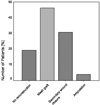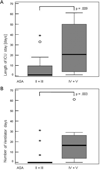Necrotizing fasciitis: microbiological characteristics and predictors of postoperative outcome
- PMID: 19258208
- PMCID: PMC3352202
- DOI: 10.1186/2047-783x-14-1-30
Necrotizing fasciitis: microbiological characteristics and predictors of postoperative outcome
Abstract
Objective: Necrotizing fasciitis is a life threatening soft-tissue infection with a high morbidity and mortality. Prompt treatment based on extensive surgical debridement and antibiotic therapies are the therapeutic principles.
Methods: The medical records of patients with necrotizing fasciitis (n = 26) from 1996 to 2005 were retrospectively analyzed.
Results: The localization of necrotizing fasciitis was most commonly the trunk (42.3 %). Type I polymicrobial infection was the dominating infection. The involvement of anaerobic bacteria was associated with an increase in the number of surgical revisions (p = 0.005). Length of postoperative intensive care unit stay, duration of postoperative ventilation and mortality were significantly increased in the ASA IV-V group. Computed tomography displayed only a limited significance as diagnostic tool for initial diagnosis.
Conclusions: In severe cases the combination of necrotic skin and soft tissue gas facilitates the correct diagnosis, which should than be followed by immediate - and most often - repeated debridement. If anaerobes are isolated an early and aggressive second look is necessary.
Figures






References
MeSH terms
Substances
LinkOut - more resources
Full Text Sources

